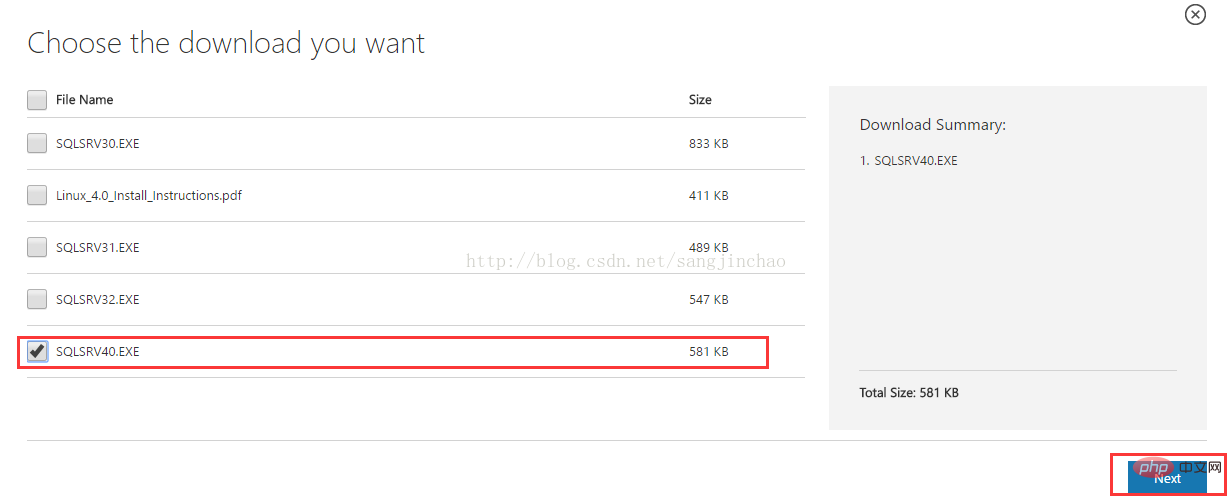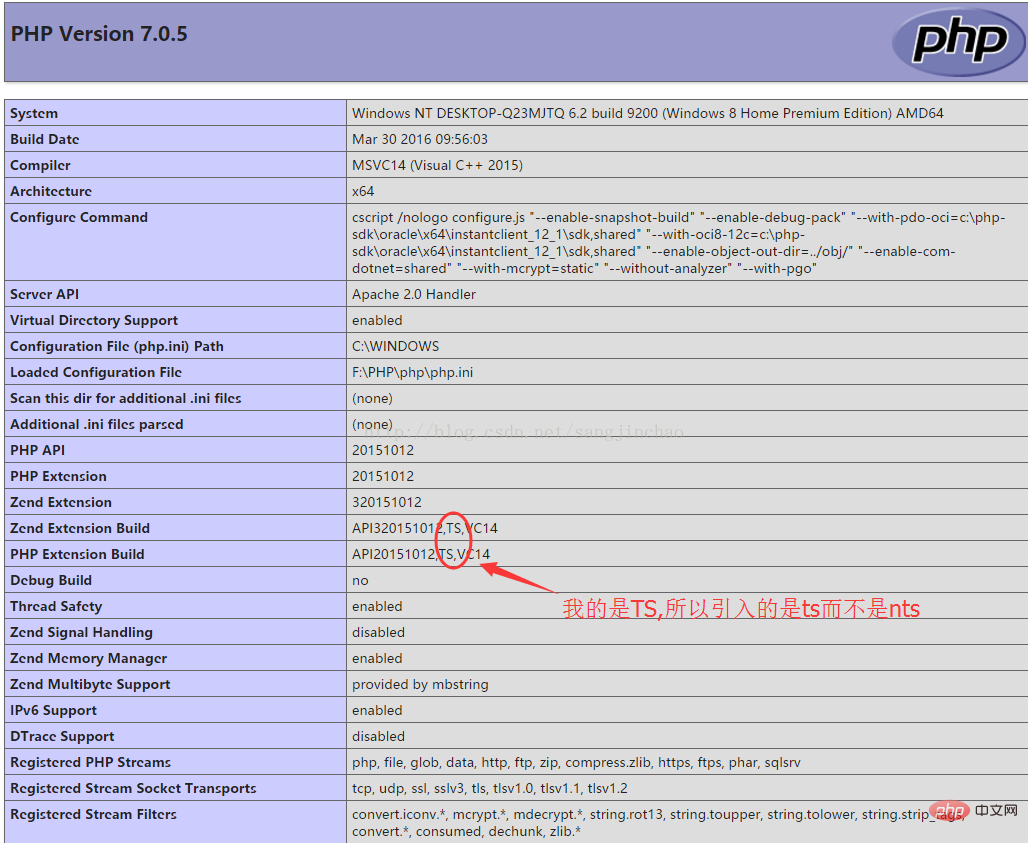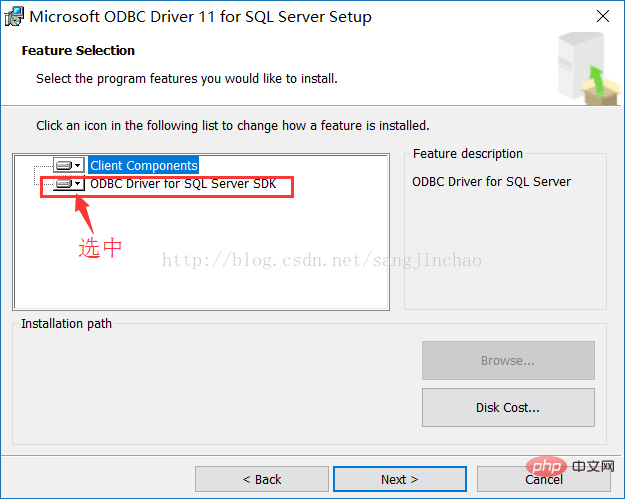What is the method to connect sqlserver in php7
This article introduces how to connect php7 to Sqlserver. It mainly includes usage examples of php7.2 connecting to Sqlserver, application skills, summary of basic knowledge points and matters needing attention. It has certain reference value and friends in need can refer to it.

First of all, php needs to enable the sqlsrv extension
1. Download SQLSRV40.EXE (supports php7.0), https:// www.microsoft.com/en-us/download/details.aspx?id=20098



Note: For the difference between ts and nts, see phpinfo

to php.ini
extension=php_sqlsrv_7_ts_x64.dllOpen extension ##5. Install ODBC Driver 11 For SQL (msodbcsql.msi)
##5. Install ODBC Driver 11 For SQL (msodbcsql.msi)
https://www.microsoft.com/en-us/download/details.aspx?id=36434
 6. Run msodbcsql.msi to complete the installation
6. Run msodbcsql.msi to complete the installation
Note:
 7. Restart apache, the sqlsrv extension is successfully opened
7. Restart apache, the sqlsrv extension is successfully opened
Note: The php7.1 version will not be successfully opened according to this method, the reason The two extension files php_pdo_sqlsrv_7_ts_x64.dll and php_sqlsrv_7_ts_x64.dll are not applicable to php7.1. Please search for these two extension files suitable for php7.1
Recommended learning:
php video tutorialThe above is the detailed content of What is the method to connect sqlserver in php7. For more information, please follow other related articles on the PHP Chinese website!

Hot AI Tools

Undresser.AI Undress
AI-powered app for creating realistic nude photos

AI Clothes Remover
Online AI tool for removing clothes from photos.

Undress AI Tool
Undress images for free

Clothoff.io
AI clothes remover

AI Hentai Generator
Generate AI Hentai for free.

Hot Article

Hot Tools

Notepad++7.3.1
Easy-to-use and free code editor

SublimeText3 Chinese version
Chinese version, very easy to use

Zend Studio 13.0.1
Powerful PHP integrated development environment

Dreamweaver CS6
Visual web development tools

SublimeText3 Mac version
God-level code editing software (SublimeText3)

Hot Topics
 How to Use Sessions Effectively in PHP 7?
Mar 10, 2025 pm 06:20 PM
How to Use Sessions Effectively in PHP 7?
Mar 10, 2025 pm 06:20 PM
This article details effective PHP 7 session management, covering core functionalities like session_start(), $_SESSION, session_destroy(), and secure cookie handling. It emphasizes security best practices including HTTPS, session ID regeneration, s
 How to Monitor PHP 7 Performance with Tools like New Relic?
Mar 10, 2025 pm 06:28 PM
How to Monitor PHP 7 Performance with Tools like New Relic?
Mar 10, 2025 pm 06:28 PM
This article explains how to monitor PHP 7 application performance using New Relic. It details New Relic's setup, key performance indicators (KPIs) like Apdex score and response time, bottleneck identification via transaction traces and error track
 How to Upgrade from PHP 5.6 to PHP 7?
Mar 10, 2025 pm 06:29 PM
How to Upgrade from PHP 5.6 to PHP 7?
Mar 10, 2025 pm 06:29 PM
This article details upgrading PHP 5.6 to PHP 7, emphasizing crucial steps like backing up, checking server compatibility, and choosing an upgrade method (package manager, compiling, control panel, or web server configuration). It addresses potentia
 How to Autoload Classes in PHP 7?
Mar 10, 2025 pm 06:20 PM
How to Autoload Classes in PHP 7?
Mar 10, 2025 pm 06:20 PM
This article explains PHP 7's autoloading, using spl_autoload_register() to load classes on demand. It details best practices like namespace-based autoloading and caching for performance optimization, addresses common issues (e.g., class not found
 How to Use Git for Version Control in PHP 7 Projects?
Mar 10, 2025 pm 06:27 PM
How to Use Git for Version Control in PHP 7 Projects?
Mar 10, 2025 pm 06:27 PM
This article guides PHP 7 developers on using Git for version control. It covers initialization, staging, committing, ignoring files, remote repositories, branching, merging, conflict resolution, and essential Git commands. Best practices for effic
 How to Deploy a PHP 7 Application to a Web Server?
Mar 10, 2025 pm 06:28 PM
How to Deploy a PHP 7 Application to a Web Server?
Mar 10, 2025 pm 06:28 PM
This article details deploying PHP 7 applications, covering methods (FTP, SSH, deployment tools), server configuration (Apache/Nginx, PHP-FPM), database setup, and crucial security considerations. It highlights common challenges like server compatib
 How to Use Xdebug for Debugging PHP 7 Code?
Mar 10, 2025 pm 06:26 PM
How to Use Xdebug for Debugging PHP 7 Code?
Mar 10, 2025 pm 06:26 PM
This article explains how to use Xdebug for debugging PHP 7 code. It covers Xdebug configuration (installation, php.ini settings, IDE setup), breakpoint usage (conditional, function, remote), and troubleshooting connection issues. Effective debuggi
 What is Object-Oriented Programming (OOP) in PHP 7?
Mar 10, 2025 pm 02:53 PM
What is Object-Oriented Programming (OOP) in PHP 7?
Mar 10, 2025 pm 02:53 PM
This article explains Object-Oriented Programming (OOP) in PHP 7, highlighting its benefits: modularity, reusability, maintainability, and improved code organization. It details classes, objects, inheritance, and polymorphism, illustrating their use






